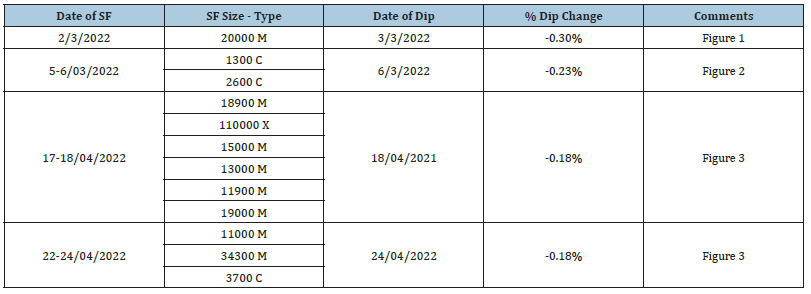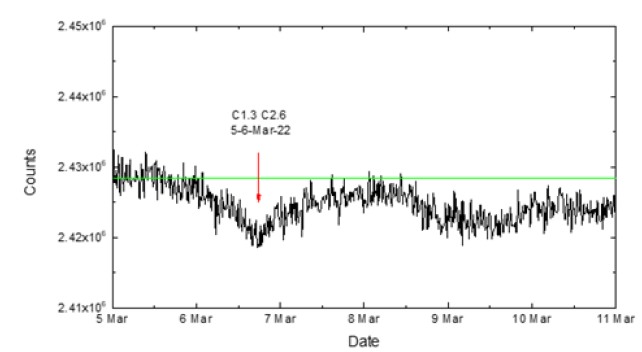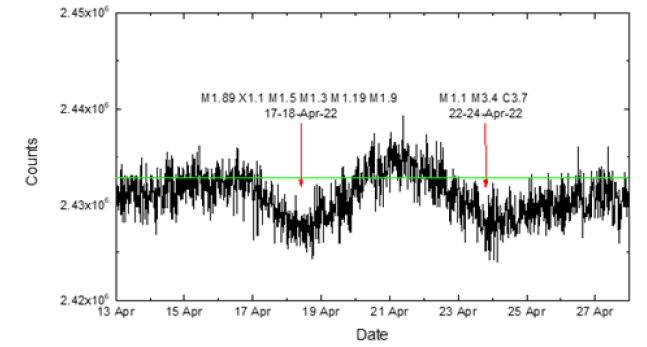- Submissions

Full Text
Aspects in Mining & Mineral Science
The Effects of Solar Flare on Radium Half-Life Based Radiological Dating
Yael Peleg, Jonathan Walg and Itzhak Orion*
Ben Gurion University of the Negev, Beer Sheva, Israel
*Corresponding author: Itzhak Orion, Ben Gurion University of the Negev, Beer Sheva, Israel
Submission: September 05, 2022;Published: September 15, 2022

ISSN 2578-0255Volume9 Issue5
Abstract
Geological dating using radioactive materials is a commonly used method that entails known uncertainties. In this study we investigated whether some of these known uncertainties result from changes in the decay rates of the Uranium decay chain. The Uranium decay chain includes Ra-222 radioactive gas decay. In previous studies, we presented the hypothesis that neutrino flux rises during the eruption of solar flares, reacts with the radioactive nucleus, and thus can alter its decay rate. NaI(Tl) detectors for gamma radiation measurements, facing Rn-222 gas that was in equilibrium with a Ra-226 source, were utilized to conduct count rate measurements. Throughout the period of these measurements, we tracked solar flare events. Our findings indicate that the Rn-222 radioactive isotope decay was affected by an orders-of-magnitude rise in the neutrino flux caused by strong solar flares. Monte Carlo simulation was performed to simulate the change in the Radium decay rate over a duration of solar activity, based on the measured counts dips, and tallied with the magnitude and incidence of solar flare events. The results demonstrate that the half-life of Ra-226 rose by 6% from the value ascribed in the literature its literature value due to the solar activity. The half-life change found in previous research concerning Th-232 was 35%, a much greater change that could alter radiometric dating results. However, the change in the half-life of Ra-226 is relatively small and will not make an apparent difference to radiometric dating. We conclude that solar flares affect the half-lives of different radioisotopes in different ways, encouraging further investigation of this kind.
Keywords:Half-life; Solar flare; Dating; Decay constant; Radioactive
Introduction
Previous studies presented the hypothesis that the neutrino flux created during the occurrence of a solar flare can penetrate a radioactive nucleus and thus possibly change its half-life [1,2]. The effect of solar flares on the decay of radioactive materials was first noted by Jenkins [3] with significant ground-breaking results, which influenced the field of nuclear physics. In previous publications we demonstrated that solar flares caused changes in the decay rates of Am-241, Rn-222, Th-232, Mn-54 and Co-57 [1,2,4,5]. Our previous study presented for the first time the implications of these findings on geological dating as a result of a decay constant change [2]. The radioactive material studied was Th-232, which is used for geological dating. However, further radioactive sources are influenced and impacted by changes in neutrino flux during solar flares. The Th-232 count-rate measurements showed several dips, indicating that the radioactive nuclide is affected by neutrino flux change from the sun [2]. In previous research, we developed a new formula that enabled us to simulate the radiometric aging corrections for Th-232 [2]. Considering the dip amplitude, a calculation of the overall changes in decay constant was carried out, indicating the consequences of solar flares for the half-life of Th-232. Based on the simulation using the new formula, a significant change in the dating was discerned: a change of millions of years between the measured age and the real age using Th-232, due to decay rate changes as a consequence of solar flares. The Uranium decay chain radioisotopes are commonly used for radiometric dating methods. Rn-222 (3.8 days half-life) is an alpha and gamma emitter that is part of the Uranium-Lead decay chain. Its parent radioactive isotope is Ra-226 (1600 years half-life). The Rn-222 decay reached equilibrium to its parent, Ra-226, after three weeks. The decay of U-234 to Th-230 is part of the decay chain of the Uranium-Lead decay chain. The difference between the initial amount rate of Th-230/U-234 and the accumulated rate of a sample enables us to assess the sample age. In this study we expanded the research and studied the influence of solar flares on an additional radioactive isotope, Rn- 222 and the impact on its decay rate.
Methods
We set up a measurement Rn-222 system and registered the gamma radiation count-rate responses due to the occurrence of solar flare events through satellites that continuously monitor solar activity [6]. An Ra-226 sealed source facing the counting system was constructed to track count-rate changes. Rn-222, which is produced by Ra-226 source decay, with activity of 300kBq, was placed inside a -40 °C freezer to reduce random radon gas motion [1]. The NaI(Tl) radiation detector, shielded by 5cm thick lead bricks, faced the source, measuring gamma rays from Rn-222. The counting system was mounted in an underground lab that is permanently locked to avoid any external influence and environmentally controlled in terms of temperature, humidity, and clean airflow. The detector counting is integrated and collected every 15 minutes.
Results and Discussion
Experimental results
A solar flare is a phenomenon that cannot be predicted in advance; therefore, the measurement system works continuously. The size and magnitude of solar flares are categorized as types A, B, C, M, X. Once a solar flare occurs, significant decreases in the count rates of the radioactive sources were detected. During March and April 2022 severe solar flares were detected by GOES satellites, and those solar flare caused changes in the decay rate of Rn-222, which were reflected as decreases in the gamma radiation counts; all the observed decreases are summarized in Table 1. The Rn-222 count rate responded to strong Solar Flares (SF), type C or above, during 2022. Throughout the measurement period, the room temperature was stable at 18 ±1 °C, thus avoiding effects on the detector performance. Changes in the Rn-222 count rate due to solar flares were indicated during the measurement period March to April 2022. The gamma radiation count dips are depicted in Figure 1-3. In Figure 1 a dip occurred after an M2 magnitude SF. In Figure 2, a dip was detected after C1.3+C2.6 magnitude SFs. In Figure 3 two dips were detected: the first after a bundle of SF of M and X1 magnitudes, and the second dip after C3.7, M1.1, M3.4 magnitude flares. The Rn- 222 clearly responded to SFs of C magnitude or larger.
Table 1:Solar flares that affected Rn-222 measured count rate decreases. Left to right: Solar flare occurrence date; SF maximal flux - size in nW.m-2 and type; the measured dip date; and the change in percentage.

Figure 1:Rn-222 measured counts from 1- March - 2022 to 6- March – 2022. The green horizontal line is the counts average. A dip is indicated by an arrow. SF type and event date are presented.

Figure 2:Rn-222 measured counts from 5- March - 2022 to 11- March – 2022. The green horizontal line is the counts average. A dip is indicated by an arrow. SF types and event date are presented.

Figure 3: Rn-222 measured counts from 13- April - 2022 to 28- April – 2022. The green horizontal line is the counts average. Twos dips are indicated by arrows. SF types and event dates are presented.

To verify the dip in our measurements for Rn-222—it is a reliable result if the count rate exceeds its mean value—we used the ‘limits-of-detectability’ method [7]. The Critical Level (LC) was calculated from the measured data counts of 01-Mar-2022 to 30-Apr-2022. The obtained LC was used to inspect the dips using the neighboring count rate moments. Then, the counts at the dip were compared to the LC (in percentage) that is equal to 2.326 times standard deviation (as definition “a 95% probability that a random sample will lie below the mean plus 1.645σ“). A reliable signal was considered as one detected when the presented dip counts exceeded the LC value. According to the current statistical significance calculations, a count rate change of at least 0.14% indicated a reliable detection. Therefore, all detected dips reported in Table 1 are reliable.
Simulation
In our previous study we introduced the change in the half-life of Th-232 due to solar flares and their intensity [2]. We developed the following formula to simulate the relationship between the magnitude of the solar flares and their effect on the Ra-226 decay constant, based on the Rn-222 counts change.

Where:
λchange – Modified Decay Constant altered by solar flare events
λ – Decay Constant (according to the literature)
Δi – Random variable sampled subsequential dip distribution
due to solar flare types
Corresponding to our recent dip detections, we incorporated the influence of type C or larger magnitude solar flares into our simulation.
Δi dependency was obtained corresponding to the dip range: for Type B the range was set to zero (no dips), and for Type C, Type M, Type X the range was set to (-0.18%) – (-0.3%). These ranges were obtained from a set of measured dip responses for Rn-222. The SF data was collected for the years 2015 – 2022 (June) to cover the effect of the half branch of the 11-year solar activity cycle.
The simulation results provided corrected half-life with a different change per year. Different numbers of solar flares with different magnitudes were registered in each year. For the year 2015, the calculated half-life change was 21.9% due to maximum solar flare occurrence, for 2018 the change was 0.2% due to a minimum of SF events, and for 2022 (until June) the change was 21.2%. The overall changes led to a 6.32% (±0.1%) increase in halflife. The previous Monte Carlo simulation for assessment of Th-232 dating obtained a half-life change of 35% [2]. The change in the half-life of Ra-226 half-life discerned in this research is around 6%. The decay constant change can only decrease, hence increasing the apparent half-life, however different radioisotopes demonstrated a significant difference in change.
Conclusion
Due to our novel findings in Reference [2], radiometric dating methods should be re-evaluated and re-calculated, thus we continued the research, focusing on Rn-222 measurements. The Rn-222 count-rate measurements showed several dips in gamma rays counting, indicating that the radioactive nuclide can be affected by neutrino flux from the sun. Our previous study found that the half-life of Th-232 increased by 35%. Ra-226 half-life increased by only 6%. Dating methods using Thorium [8,9] are significantly altered as opposed to dating using Radium [10,11]. We conclude that Rn-222 is affected only by stronger solar flares, which are less frequent; therefore, geological dating methods based on Radium are relatively robust.
References
- Walg J, Rodnianski A, Orion I (2020) Solar flare detection method using Rn-222 radioactive source. GSC Advanced Research and Reviews 5(2): 159-166.
- Peleg Y, Walg J, Orion I (2021) Solar flare effect on geological thorium radiometric dating. AMMS 7(1): 772-776.
- Jenkins JH, Fischbach E (2009) Perturbation of nuclear decay rates during the solar flare of 2006 December 13. Astroparticle Physics 31(6): 407-411.
- Walg J, Rodnianski A, Orion I (2019) Evidence of neutrino flux effect on alpha emission radioactive half-life. ATINER’s Conference Paper Proceedings Series PHY2019-0137, Athens, Greece.
- Walg J, Peleg Y, Orion I (2021) Effect of solar flares on 54Mn and 57Co radioactive decay. Nuclear Technology & Radiation Protection 36(3): 219-223.
- https://www.swpc.noaa.gov/products/goes-x-ray-flux
- Knoll GF (2000) Radiation detection and measurement. (3rd edn), Wiley, US.
- Vértes A, Nagy S, Suvegh K (1998) Nuclear methods in minerology and geology techniques and applications. Springer Science, Germany.
- Villemant B, Feuillet N (2003) Dating open systems by the 238U-234U-230Th Method: Application to quaternary reef terraces. Earth and Planetary Science Letters 210(1-2): 105-118.
- Peppe DJ, Deino AL (2013) Dating rocks and fossils using geologic methods. Nature Education Knowledge 4(10): 1.
- Ovtcharova M, Goudemand N, Hammer Q, Guodun K, Cordey F, et al. (2015) Developing a strategy for accurate definition of a geological boundary through radio-isotopic and biochronological dating: The early–middle triassic boundary (South China). Earth-Sciences Reviews 146: 65-76.
© 2022 Itzhak Orion. This is an open access article distributed under the terms of the Creative Commons Attribution License , which permits unrestricted use, distribution, and build upon your work non-commercially.
 a Creative Commons Attribution 4.0 International License. Based on a work at www.crimsonpublishers.com.
Best viewed in
a Creative Commons Attribution 4.0 International License. Based on a work at www.crimsonpublishers.com.
Best viewed in 







.jpg)






























 Editorial Board Registrations
Editorial Board Registrations Submit your Article
Submit your Article Refer a Friend
Refer a Friend Advertise With Us
Advertise With Us
.jpg)






.jpg)














.bmp)
.jpg)
.png)
.jpg)










.jpg)






.png)

.png)



.png)






